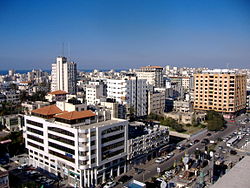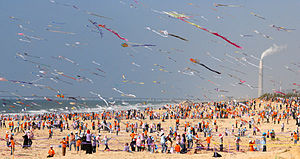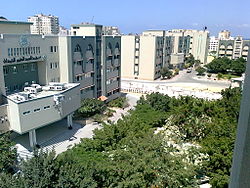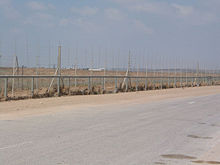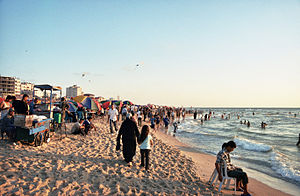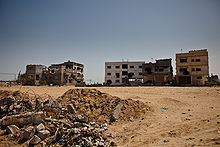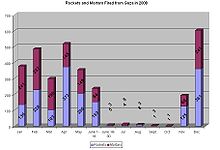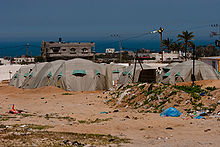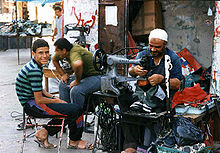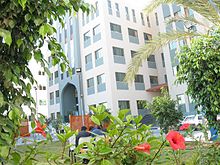
Gaza Strip
Background Information
SOS Children made this Wikipedia selection alongside other schools resources. Child sponsorship helps children one by one http://www.sponsor-a-child.org.uk/.
| Gaza Strip | ||||
|---|---|---|---|---|
|
||||
|
|
||||
| Capital | Gaza | |||
| Official languages | Arabic | |||
| Government | ||||
| - | Prime Minister | Ismail Haniyeha | ||
| - | President | Aziz Duwaik | ||
| Area | ||||
| - | Total | 360 km2 139 sq mi |
||
| Population | ||||
| - | 2011 estimate | 1,657,155 | ||
| GDP ( PPP) | 2009 estimate | |||
| - | Total | $770 million ( –) | ||
| - | Per capita | $3,100 ( –) | ||
| Currency |
EGP, ILS) |
|||
| Time zone | ( UTC+2) | |||
| - | Summer ( DST) | ( UTC+3) | ||
| Calling code | +970 | |||
| Internet TLD |
|
|||
| a. | Haniyeh was dismissed by President Mahmoud Abbas in favour of Fayad. However, along with the Palestinian Legislative Council, Haniyeh does not acknowledge the legitimacy of his dismissal. Since 14 June 2007, Haniyeh has exercised de facto authority in the Gaza Strip, whereas Fayad's government has authority in the West Bank. | |||
| b. | Used in the Gaza Strip since 1951. | |||
| c. | Used since 1985. | |||
The Gaza Strip (Arabic: قطاع غزة Qiṭāʿ Ġazzah, IPA: [qɪˈtˤɑːʕ ˈɣazza]) is a territory on the eastern coast of the Mediterranean Sea that borders Egypt on the southwest (11 km) and Israel on the east and north (51 km (32 mi)). It is 41 kilometres (25 mi) long, and from 6 to 12 kilometres (3.7 to 7.5 mi) wide, with a total area of 365 square kilometres (141 sq mi). The population of Gaza Strip is about 1.7 million people. The population is predominantly Sunni Muslim. With a yearly growth rate of about 3.2%, the Gaza Strip has the 7th highest population growth rate in the world.
The Gaza Strip acquired its current northern and eastern boundaries at the cessation of fighting in the 1948 war, confirmed by the Israel-Egypt Armistice Agreement on 24 February 1949. Article V of the Agreement declared that the demarcation line was not to be an international border. The Gaza Strip continued to be occupied by Egypt. At first Gaza Strip was officially administered by the All-Palestine Government, established by the Arab League in September 1948. From the dissolution of the All-Palestine Government in 1959 until 1967, the Gaza Strip was directly administered by an Egyptian military governor. Israel captured the Gaza Strip from Egypt in the Six-Day War in 1967. Pursuant to the Oslo Accords signed in 1993, the Palestinian Authority became the administrative body that governed Palestinian population centers. Israel maintained control of the airspace, territorial waters and border crossings apart from the land border with Egypt. Israel withdrew from Gaza in 2005. Since July 2007, following the 2006 Palestinian legislative election and following the Hamas takeover in 2007, Hamas has functioned as the de facto ruler in the Gaza Strip, forming an alternative Hamas Government in Gaza.
The Gaza Strip forms part of the Palestinian territories, now claimed by the State of Palestine.
Background
British rule (1923–1948)

The Palestine Mandate was based on the principles contained in Article 22 of the draft Covenant of the League of Nations and the San Remo Resolution of 25 April 1920 by the principal Allied and associated powers after the First World War. The mandate formalised British rule in the southern part of Ottoman Syria from 1923–1948.
History
All-Palestine government
On 22 September 1948, towards the end of the 1948 Arab-Israeli War, the All-Palestine government was proclaimed in the Egyptian occupied Gaza City by the Arab League. It was conceived partly as an Arab League attempt to limit the influence of Transjordan in Palestine. The All-Palestine Government was quickly recognized by six of the then seven members of the Arab League: Egypt, Syria, Lebanon, Iraq, Saudi Arabia, and Yemen, but not by Transjordan. It was not recognised by any country outside the Arab League.
After the cessation of hostilities, the Israel-Egypt Armistice Agreement of 24 February 1949 established the separation line between Egyptian and Israeli forces, and established what became the present boundary between the Gaza Strip and Israel. Both sides declared that the boundary was not an international border. The southern border with Egypt continued to be the international border which had been drawn in 1906 between the Ottoman Empire and the British Empire.
Palestinians living in the Gaza Strip or Egypt were issued All-Palestine passports. Egypt did not offer them citizenship. From the end of 1949, they received aid directly from UNRWA. During the Sinai campaign of November 1956, the Gaza Strip and the Sinai Peninsula were occupied by Israeli troops, who withdrew under international pressure. The government was accused of being little more than a façade for Egyptian control, with negligible independent funding or influence. It subsequently moved to Cairo and dissolved in 1959 by decree of Egyptian President Gamal Abdul Nasser.
Egyptian occupation (1959–1967)
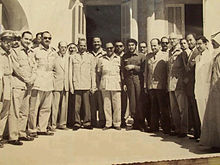
After the dissolution of the All-Palestine Government in 1959, under the excuse of pan-Arabism, Egypt continued to occupy the Gaza Strip until 1967. Egypt never annexed the Gaza Strip, but instead treated it as a controlled territory and administered it through a military governor. The influx of over 200,000 refugees into Gaza during the war resulted in a dramatic decrease in the standard of living. Because the Egyptian government restricted movement to and from the Gaza Strip, its inhabitants could not look elsewhere for gainful employment.
Israeli control
Beginning in June 1967, following the Six-Day War, Israel once again controlled the Gaza Strip. During this period, Israel created a settlement bloc, Gush Katif, in the southwest corner of the Strip near Rafah and the Egyptian border. In total, Israel created 21 settlements in the Gaza Strip, comprising 20% of the total territory. Besides ideological reasons, these settlements also served Israel's security concerns.
In March 1979, Israel and Egypt signed the Israel-Egypt Peace Treaty. Among other things, the treaty provided for the withdrawal by Israel of its armed forces and civilians from the Sinai Peninsula, which Israel had captured during the Six-Day War, to the 1906 international border. The Egyptians agreed to keep the Sinai Peninsula demilitarized. The final status of the Gaza Strip, and other relations between Israel and Palestinians, was not dealt with in the treaty. Egypt renounced all territorial claims to territory north of the international border.
The Gaza Strip remained under Israeli military administration until 1994. During that time, the military was responsible for the maintenance of civil facilities and services.
Palestinian Authority
In May 1994, following the Palestinian-Israeli agreements known as the Oslo Accords, a phased transfer of governmental authority to the Palestinians took place. Much of the Strip (except for the settlement blocs and military areas) came under Palestinian control. The Israeli forces left Gaza City and other urban areas, leaving the new Palestinian Authority to administer and police those areas. The Palestinian Authority, led by Yasser Arafat, chose Gaza City as its first provincial headquarters. In September 1995, Israel and the PLO signed a second peace agreement, extending the Palestinian Authority to most West Bank towns. The agreement also established an elected 88-member Palestinian National Council, which held its inaugural session in Gaza in March 1996.
Palestinian Authority rule under the leadership of Arafat suffered from serious mismanagement and corruption scandals. For example, exorbitant bribes were demanded for allowing goods to pass in and out of the Gaza Strip, while heads of the Preventive Security Service apparatus profited from their involvement in the gravel import and cement and construction industries, such as the Great Arab Company for Investment and Development, the al-Motawaset Company, and the al-Sheik Zayid construction project.
Between 1994 and 1996, Israel built the Israeli Gaza Strip barrier to improve security in Israel. The barrier was largely torn down by Palestinians at the beginning of the Al-Aqsa Intifada in September 2000.
Second Intifada
The Second Intifada broke out in September 2000 with its waves of protest, civil unrest and bombings against Israeli military and civilians, many of them perpetrated by suicide bombers, and the beginning of rockets and bombings of Israeli border localities by Palestinian guerrillas from Gaza Strip, especially from Hamas and Jihad Islamic movements.
Between December 2000 and June 2001, the barrier between Gaza and Israel was reconstructed. A barrier on the Gaza Strip-Egypt border was constructed starting in 2004. The main crossing points are the northern Erez Crossing into Israel and the southern Rafah Crossing into Egypt. The eastern Karni Crossing used for cargo, closed down in 2011. Israel controls the Gaza Strip's northern borders, as well as its territorial waters and airspace. Egypt controls Gaza Strip's southern border, under an agreement between it and Israel.
In February 2005, the Knesset approved a unilateral disengagement plan and began evacuating Israeli settlers from the Gaza Strip on August 15, 2005. The evacuation was completed on September 12. All Israeli settlements in the Gaza Strip and the joint Israeli-Palestinian Erez Industrial Zone were dismantled, and 9,000 Israelis, most living in Gush Katif, were forcibly evicted.
On September 12, 2005, the Israeli cabinet formally declared an end to Israeli military occupation of the Gaza Strip. To avoid allegations that it was still in occupation of any part of the Gaza Strip, Israel also withdrew from the Philadelphi Route, a narrow strip of land adjacent to the border with Egypt, after Egypt agreed to secure its side of the border. Under the Oslo Accords, the Philadelphi Route was to remain under Israeli control to prevent the smuggling of weapons and people across the Egyptian border, but Egypt committed itself to patrolling the area and preventing such incidents. Israel maintained control over the crossings in and out of Gaza, and the Rafah crossing between Egypt and Gaza was monitored by special surveillance cameras.
Israel's unilateral disengagement in 2005
The Israel Defense Forces left the Gaza Strip on 1 September 2005 as part of Israel's unilateral disengagement plan and all Israeli citizens were evicted from the area. In November 2005, an "Agreement on Movement and Access" between Israel and the Palestinian Authority was brokered by then US Secretary of State Condoleezza Rice to improve Palestinian freedom of movement and economic activity in the Gaza Strip. Under its terms, the Rafah crossing with Egypt was to be reopened, with transits monitored by the Palestinian National Authority and the European Union. Only people with Palestinian ID, or foreign nationals, by exception, in certain categories, subject to Israeli oversight, were permitted to cross in and out. All goods, vehicles and trucks to and from Egypt passed through the Kerem Shalom Crossing, under full Israeli supervision. Goods were also permitted transit at the Karni crossing in the north.
After the Israeli withdrawal on 12 September 2005, the Palestinian Authority had complete administrative authority in the Gaza Strip. The Rafah Border Crossing has been supervised by EU Border Assistance Mission Rafah under an agreement finalised in November 2005. However, since the 2005 withdrawal, Israel continues control the Gaza Strip's airspace and sea space.
Post-2006 elections violence
In the Palestinian parliamentary elections held on January 25, 2006, Hamas won a plurality of 42.9% of the total vote and 74 out of 132 total seats (56%). When Hamas assumed power the next month, the Israeli government and the key players of the international community, the United States and the EU, refused to recognize its right to govern the Palestinian Authority. Direct aid to the Palestinian government there was cut off, although some of that money was redirected to humanitarian organizations not affiliated with the government. The resulting political disorder and economic stagnation led to many Palestinians emigrating from the Gaza Strip.
In January 2007, fighting erupted between Hamas and Fatah. The deadliest clashes occurred in the northern Gaza Strip, where General Muhammed Gharib, a senior commander of the Fatah-dominated Preventive Security Force, died when a rocket hit his home. Gharib's two daughters and two bodyguards were also killed in the attack, carried out by Hamas gunmen.
At the end of January 2007, a truce was negotiated between Fatah and Hamas. However, after a few days, new fighting broke out. Fatah fighters stormed a Hamas-affiliated university in the Gaza Strip. Officers from Abbas' presidential guard battled Hamas gunmen guarding the Hamas-led Interior Ministry.
In May 2007, new fighting broke out between the factions. Interior Minister Hani Qawasmi, who had been considered a moderate civil servant acceptable to both factions, resigned due to what he termed harmful behaviour by both sides.
Fighting spread in the Gaza Strip, with both factions attacking vehicles and facilities of the other side. Following a breakdown in an Egyptian-brokered truce, Israel launched an air strike which destroyed a building used by Hamas. Ongoing violence prompted fear that it could bring the end of the Fatah-Hamas coalition government, and possibly the end of the Palestinian authority.
Hamas spokesman Moussa Abu Marzouk blamed the worsening situation on Israel, stating that the constant pressure of economic sanctions resulted in the "real explosion." Associated Press reporter Ibrahim Barzak wrote an eyewitness account stating:
Today I have seen people shot before my eyes, I heard the screams of terrified women and children in a burning building, and I argued with gunmen who wanted to take over my home. I have seen a lot in my years as a journalist in Gaza, but this is the worst it's been.
From 2006-2007 more than 600 Palestinians were killed in fighting between Hamas and Fatah. In the aftermath of the Gaza War, a series of violent acts killed 54 Palestinians, while hundreds have claimed they were tortured. 349 Palestinians were killed in fighting between factions in 2007. 160 Palestinians killed each other in June alone.
Hamas rule (2007–present)
Following the victory of Hamas in the 2006 Palestinian legislative election, Hamas and Fatah formed a Palestinan authority national unity government headed by Ismail Haniya. Shortly after, Hamas took control of the Gaza Strip in the course of the Battle of Gaza, seizing government institutions and replacing Fatah and other government officials with its own. By 14 June, Hamas fully controlled the Gaza Strip. Palestinian President Mahmoud Abbas responded by declaring a state of emergency, dissolving the unity government and forming a new government without Hamas participation. PNA security forces in the West Bank arrested a number of Hamas members.
In late June 2008, Egypt, Jordan and Saudi Arabia said that the West Bank-based Cabinet formed by Abbas was the sole legitimate Palestinian government and Egypt moved its embassy from Gaza to the West Bank.
Saudi Arabia and Egypt supported reconciliation and a new unity government and pressed Abbas to start talks with Hamas. Abbas had always conditioned this on Hamas returning control of the Gaza Strip to the Palestinian Authority. Hamas visited a number of countries, including Russia, and the EU member states. Opposition parties and politicians called for a dialogue with Hamas as well as an end to the economic sanctions.
After the takeover, Israel and Egypt closed their border crossings with Gaza. Palestinian sources reported that European Union monitors fled the Rafah Border Crossing, on the Gaza–Egypt border for fear of being kidnapped or harmed. Arab foreign ministers and Palestinian officials presented a united front against control of the border by Hamas.
Meanwhile, Israeli and Egyptian security reports said that Hamas continued smuggling in large quantities of explosives and arms from Egypt through tunnels. Egyptian security forces uncovered 60 tunnels in 2007.
After the Hamas takeover
After Hamas' June win, it ousted Fatah-linked officials from positions of power and authority (such as government positions, security services, universities, newspapers, etc.) and strove to enforce law by progressively removing guns from the hands of peripheral militias, clans, and criminal groups, and gaining control of supply tunnels. According to Amnesty International, under Hamas rule, newspapers were closed down and journalists were harassed. Fatah demonstrations were forbidden or suppressed, as in the case of a large demonstration on the anniversary of Yasser Arafat's death, which resulted in the deaths of seven people, after protesters hurled stones at Hamas security forces.
Violence against Christians was recorded. The owner of a Christian bookshop was abducted and murdered and, on 15 February 2008, the Christian Youth Organization's library in Gaza City was bombed.
Hamas and other militant groups continued to fire Qassam rockets across the border into Israel. According to Israel, between the Hamas takeover and the end of January 2008, 697 rockets and 822 mortar bombs were fired at Israeli towns. In response, Israel targeted Qassam launchers and military targets and declared the Gaza Strip a hostile entity. In January 2008, Israel curtailed travel from Gaza, the entry of goods, and cut fuel supplies, resulting in power shortages. This brought charges that Israel was inflicting collective punishment on the Gaza population, leading to international condemnation. Despite multiple reports from within the Strip that food and other essentials were in short supply, Israel said that Gaza had enough food and energy supplies for weeks. In early March 2008, air strikes and ground incursions by the IDF led to the deaths of over 110 Palestinians and extensive damage to Jabalia.
Barrier breach
On 23 January 2008, after months of preparation during which the steel reinforcement of the border barrier was weakened, Hamas destroyed several parts of the wall dividing Gaza and Egypt in the town of Rafah. Hundreds of thousands of Gazans crossed the border into Egypt seeking food and supplies. Due to the crisis, Egyptian President Hosni Mubarak ordered his troops to allow the Palestinians in but to verify that they did not bring weapons back across the border. Egypt arrested and later released several armed Hamas militants in the Sinai who presumably wanted to infiltrate into Israel. At the same time, Israel increased its state of alert along the length of the Israel-Egypt Sinai border, and warned its citizens to leave Sinai "without delay."
The EU Border Monitors agreed to monitor the border if Hamas guaranteed their safety. The Palestinian Authority demanded that Egypt deal only with the Authority in negotiations relating to borders. Israel eased restrictions on the delivery of goods and medical supplies but curtailed electricity by 5% in one of its ten lines. The Rafah crossing remained closed into mid-February. In February 2008, a Haaretz poll indicated that 64% of Israelis favoured direct talks with Hamas to reach a cease-fire and secure the release of Gilad Shalit, an Israeli soldier captured in a cross border raid by Hamas militants on 25 June 2006.
In February 2008, 2008 Israel-Gaza conflict intensified, with rockets launched at Israeli cities. Military aggression by Hamas led to Israeli military action on 1 March 2008, resulting in over 110 Palestinians being killed according to BBC News, as well as 2 Israeli soldiers. Israeli human rights group B'Tselem estimated that 45 of those killed were not involved in hostilities, and 15 were minors.
After a round of tit-for-tat arrests between Fatah and Hamas in the Gaza Strip and West Bank, the Hilles clan from Gaza were relocated to Jericho on 4 August 2008. Retiring Prime Minister Ehud Olmert said on 11 November 2008, "The question is not whether there will be a confrontation, but when it will take place, under what circumstances, and who will control these circumstances, who will dictate them, and who will know to exploit the time from the beginning of the ceasefire until the moment of confrontation in the best possible way.” On 14 November 2008, Gaza was blockaded by Israel after a five-month ceasefire broke down. Food, power and water can still enter from Egypt as and when the Egyptian authorities allow it.
On 25 November 2008, Israel closed its cargo crossing with Gaza after Qassam rockets were fired into its territory. On November 28, after a 24-hour period of quiet, the IDF facilitated the transfer of over thirty truckloads of food, basic supplies and medicine into Gaza and transferred fuel to the area's main power plant.
Gaza War
On 27 December 2008, Israeli F-16 strike fighters launched a series of air strikes against targets in Gaza following the breakdown of a temporary truce between Israel and Hamas. Israeli defense sources said that Defense Minister Ehud Barak instructed the IDF to prepare for the operation six months before it began, using long-term planning and intelligence-gathering. Various sites being used as weapons depots were struck: police stations, schools, hospitals, UN warehouses, mosques, various Hamas government buildings and other buildings. Israel said that the attack was a response to Hamas rocket attacks on southern Israel, which totaled over 3,000 in 2008, and which intensified during the few weeks preceding the operation. Palestinian medical staff claimed at least 434 Palestinians were killed, and at least 2,800 wounded, consisting of many civilians and an unknown number of Hamas members, in the first five days of Israeli strikes on Gaza. The IDF denied that the majority of the dead were civilians, providing evidence that Hamas deliberately hid weapons and fighters in "mosques, school yards and civilian houses" to deter an attack and exploit Israel's rules of engagement. Israel began a ground invasion of the Gaza Strip on 3 January 2009. Israel rebuffed many cease-fire calls and both sides declared unilateral cease-fires.
A total of 1,100-1,400 Palestinians and 13 Israelis were killed in the 22-day war. After 22 days of fighting, Israel declared a ceasefire. Hamas vowed to continue the battle if Israeli forces did not leave the Strip. The conflict damaged or destroyed tens of thousands of homes, 15 of Gaza’s 27 hospitals and 43 of its 110 primary health care facilities, 800 water wells, 186 greenhouses, and nearly all of its 10,000 family farms; leaving 50,000 homeless, 400,000-500,000 without running water, one million without electricity, and resulting in acute food shortages.
By February 2009, food availability returned to pre-war levels but a shortage of fresh produce was forecast due to damage sustained by the agricultural sector.
Gaza blockade
The blockade of the Gaza Strip continued after the war, although Israel allowed in limited quantities of medical humanitarian aid. The Red Cross claimed that the blockade harmed the economy and caused a shortage of basic medicines and equipment such as painkillers and x-ray film.
Director of the Shin Bet (Israel Security Agency) Yuval Diskin did not oppose easing trade restrictions but said that smuggling tunnels in Sinai and an open seaport in the Gaza Strip endangered Israel's security. According to Diskin, Hamas and Islamic Jihad had smuggled over "5,000 rockets with ranges up to 40 kilometers." Some of the rockets could reach as far as the Tel Aviv Metropolitan Area.
Israeli spokesman Mark Regev described Israel's actions as "sanctions," not a blockade, but a Gazan legal consultant for UNRWA called the blockade "an action outside of international law.”
In July 2010, British Prime Minister David Cameron said that "humanitarian goods and people must flow in both directions. Gaza cannot and must not be allowed to remain a prison camp." In response, the spokesman for the Israeli embassy in London said "The people of Gaza are the prisoners of the terrorist organisation Hamas. The situation in Gaza is the direct result of Hamas' rule and priorities."
The Arab League accused Israel of waging a financial war. The IDF strictly controlled travel within the area of the crossing points between Israel and the Gaza Strip, and sealed its border with Gaza. U.S. government travel guides warned tourists that the region was dangerous.
Facing mounting international pressure, Egypt and Israel lessened the restrictions starting in June 2010, when the Rafah border crossing from Egypt to Gaza was partially opened by Egypt. Egypt’s foreign ministry said that the crossing would remain open mainly for people, but not for supplies. Israel announced that it would allow the passage of civilian goods but not weapons and items that could be used for dual purposes.
In January and February 2011, the United Nations Office for the Coordination of Humanitarian Affairs (UNOCHA) assessed measures taken to ease the blockade and concluded that they were not sufficient to improve the lives of the local inhabitants. UNOCHA called on Israel to fully abolish the blockade including restrictions on exports and the import of construction materials, and to lift the general ban on movement between Gaza and the West Bank via Israel. After Egypt's President Hosni Mubarak resigned on May 28, 2011, Egypt permanently opened its border with the Gaza Strip.
Non-Member Observer State Status
By September 2012, with their application for full membership stalled due to the inability of Security Council members to 'make a unanimous recommendation', the Palestine Authority had decided to pursue an upgrade in status from "observer entity" to "non-member observer state". On November 27 it was announced that the appeal had been officially made, and would be put to a vote in the General Assembly on November 29, where their status upgrade was expected to be supported by a majority of states. In addition to granting Palestine "non-member observer state status", the draft resolution "expresses the hope that the Security Council will consider favourably the application submitted on 23 September 2011 by the State of Palestine for admission to full membership in the United Nations, endorses the two state solution based on the pre-1967 borders, and stresses the need for an immediate resumption of negotiations between the two parties."
On Thursday, November 29, 2012, In a 138-9 vote (with 41 abstaining) General Assembly resolution 67/19 passed, upgrading Palestine to "non-member observer state" status in the United Nations. The new status equates Palestine's with that of the Holy See.The change in status was described by The Independent as "de facto recognition of the sovereign state of Palestine".
The vote was a historic benchmark for the sovereign State of Palestine and its citizens, whilst it was a diplomatic setback for Israel and the United States. Status as an observer state in the UN will allow the State of Palestine to join treaties and specialised UN agencies, such as the International Civil Aviation Organisation, the Law of the Seas Treaty and the International Criminal Court. It shall permit Palestine to claim legal rights over its territorial waters and air space as a sovereign state recognised by the UN. It shall also provide the citizens of Palestine with the right to sue for control of the territory that is rightfully theirs in the International Court of Justice and with the legal right to bring war-crimes charges, mainly those relating to Israel's illegal occupation of the State of Palestine, against Israel in the International Criminal Court.
The UN has permitted Palestine to title its representative office to the UN as 'The Permanent Observer Mission of the State of Palestine to the United Nations', and Palestine has started to re-title its name accordingly on postal stamps, official documents and passports, whilst it has instructed its diplomats to officially represent ' The State of Palestine', as opposed to the ' Palestine National Authority'. Additionally, on 17 December 2012, UN Chief of Protocol Yeocheol Yoon decided that "the designation of 'State of Palestine' shall be used by the Secretariat in all official United Nations documents", thus recognising the PLO-proclaimed State of Palestine as being sovereign over the territories of Palestine and its citizens under international law.
Government
2012 Hamas government
The Hamas government of 2012 was the second Palestinian Hamas-dominated government, ruling over the Gaza Strip, since the split of the Palestinian National Authority in 2007. The second Hamas government was announced on early September 2012. The reshuffle of the previous government was approved by Gaza-based Hamas MPs from the Palestinian Legislative Council (PLC) or parliament. Seven new ministers were appointed to the new government. Hamas PM Ismail Haniyeh said the new government's priorities would be "ending the siege and easing the problems of citizens, especially with regard to electricity and water."
Legal status
Egypt
Since the Egyptian–Israeli Peace Treaty 1979, a 100-meter-wide buffer zone between Gaza and Egypt known as the Philadelphi Route was established. The international border along the Philadelphi corridor between Egypt and the Gaza Strip is 7 miles (11 km) long. Since the Hamas overthrow 2007, the Philadelphi Route has been controlled by Hamas and the Egyptian army continues to destroy Gaza Strip smuggling tunnels as a countermeasure against terrorism. The Gaza border crossing into Egypt remains under the full control of Egypt. Egypt has alternately restricted or allowed goods and people to cross that terrestrial border.
Israel
In as much as it does not exercise effective control or authority over any land or institutions in the Gaza Strip, Israel states that the Gaza Strip is no longer occupied. Foreign Affairs Minister of Israel Tzipi Livni stated in January, 2008: "Israel got out of Gaza. It dismantled its settlements there. No Israeli soldiers were left there after the disengagement." After Israel withdrew in 2005, Palestinian Authority Chairman Mahmoud Abbas declared that the legal status of the areas slated for evacuation had not changed, and this lack of clarity continued after Operation Cast Lead to stop rocket fire into Israel and weapons smuggling into the Gaza strip. Israel has alternately restricted or allowed goods and people to cross the terrestrial border and handles vicariously the movement of goods in or out of Gaza by air or sea. Israel largely provides for Gaza's water supply, electricity and communications infrastructure.
Gaza
In 2012, the co-founder of Hamas, Ismail Haniyeh, the Hamas prime minister, stated that Gaza was no longer occupied.
UN and NGOs
The UN, Human Rights Watch and some other international bodies and NGOs have been reported as viewing Israel as a de facto occupying power in the Gaza Strip. Zionist NGOs and other pro-Israel entities have been reported to contest that specific view.
In his statement on the 2008–2009 Israel–Gaza conflict, Richard Falk, United Nations Special Rapporteur wrote that international humanitarian law applied to Israel "in regard to the obligations of an Occupying Power and in the requirements of the laws of war." In a 2009 interview on Democracy Now Christopher Gunness, spokesman for the United Nations Relief and Works Agency for Palestine Refugees in the Near East (UNRWA) called Israel an occupying power. Pro-Israel pundits including Meagan Buren, Senior Adviser to the media group Israel Project, Morton A. Klein, president of the Zionist Organization of America argued, unsuccessfully, against that position.
Economy
The economy of the Hamas administered Gaza Strip is severely hampered by high population density, limited land access, strict internal and external security controls, the effects of Israeli military operations, and restrictions on labor and trade access across the border. Per capita income (PPP) was estimated at US$ 3,100 in 2009, a position of 164th in the world. Seventy percent of the population is below the poverty line according to a 2009 estimate. Gaza Strip industries are generally small family businesses that produce textiles, soap, olive-wood carvings, and mother-of-pearl souvenirs; the Israelis have established some small-scale modern industries in an industrial centre. Israel supplies the Gaza Strip with electricity.
The main agricultural products are olives, citrus, vegetables, Halal beef, and dairy products. Primary exports are citrus and cut flowers, while primary imports are food, consumer goods, and construction materials. The main trade partners of the Gaza Strip are Israel and Egypt.
After Oslo (1994-2007)
Economic output in the Gaza Strip declined by about one-third between 1992 and 1996. This downturn was attributed to corruption and mismanagement by Yasser Arafat, and to Israeli closure policies. Economic development has been hindered by the lack of a sea harbour. A harbour was planned to be built in Gaza City with help from France and the Netherlands, but the project was bombed by Israel in 2001. Israel said that the Israeli settlement was being shot from the construction site at the harbour. As a result, international transports (both trade and aid) had to go through Israel, which was hindered by the imposition of generalized border closures. These also disrupted previously established labor and commodity market relationships between Israel and the Strip. A serious negative social effect of this downturn was the emergence of high unemployment.
Israel's use of comprehensive closures decreased over the next few years. In 1998, Israel implemented new policies to ease security procedures and allow freer movement of Gazan goods and labor into Israel. These changes led to three years of economic recovery in the Gaza Strip, disrupted by the outbreak of the al-Aqsa Intifada in the last quarter of 2000. Before the second Palestinian uprising in September 2000, around 25,000 workers from the Gaza Strip (about 2% of the population) used to work in Israel on daily basis.
The Second Intifada led to a steep decline in the economy of Gaza, which was heavily reliant upon export markets. The population became largely dependent on humanitarian assistance, primarily from UN agencies.
The al-Aqsa Intifada triggered tight IDF closures of the border with Israel, as well as frequent curbs on traffic in Palestinian self-rule areas, severely disrupting trade and labor movements. In 2001, and even more so in early 2002, internal turmoil and Israeli military measures led to widespread business closures and a sharp drop in GDP. Infrastructure, such as the Palestine airport, was destroyed. Another major factor was a drop in income due to reduction in the number of Gazans permitted entry to work in Israel. After the Israeli withdrawal from Gaza, the flow of a limited number of workers into Israel resumed, although Israel said it would reduce or end such permits due to the victory of Hamas in the 2006 parliamentary elections.
The Israeli settlers of Gush Katif built greenhouses and experimented with new forms of agriculture. These greenhouses provided employment for hundreds of Gazans. When Israel withdrew from the Gaza Strip in the summer of 2005, some of the greenhouses were purchased with money raised by former World Bank president James Wolfensohn, and given to Palestinians to jump-start their economy, many were demolished by Hamas, while others were demolished by the departing settlers. The effort faltered due to limited water supply, Palestinian looting, restrictions on exports and corruption in the Palestinian Authority. Many Palestinian companies repaired the greenhouses damaged and looted in the process of Israeli withdrawal.
In 2005, after the Israeli withdrawal from the Gaza Strip, Gaza businessmen envisaged a "magnificent future." $1.1 million was invested in an upscale restaurant, Roots, and plans were made to turn one of the Israeli settlements into a family resort.
Following Hamas takeover (2007-present)
Israel, the United States, Canada, and the European Union have frozen all funds to the Palestinian government after the formation of a Hamas-controlled government after its victory in the 2006 Palestinian legislative election. They view the group as a terrorist organization, and have pressured Hamas to recognize Israel, renounce violence, and make good on past agreements. Prior to disengagement, 120,000 Palestinians from Gaza were employed in Israel or in joint projects. After the Israeli withdrawal, the gross domestic product of the Gaza Strip declined. Jewish enterprises shut down, work relationships were severed and job opportunities in Israel dried up. After the 2006 elections, fighting broke out between Fatah and Hamas, which Hamas won in the Gaza Strip on 14 June 2007. Israel imposed a blockade, and the only goods permitted into the Strip through the land crossings were goods of a humanitarian nature.
An easing of Israel's closure policy in 2010 resulted in an improvement in some economic indicators, although exports were still restricted. According to the Israeli Defense Forces and the Palestinian Central Bureau of Statistics, the economy of the Gaza Strip improved in 2011, with a drop in unemployment and an increase in GDP. New malls opened and local industry began to develop. This economic upswing has led to the construction of hotels and a rise in the import of cars. Wide-scale development has been made possible by the unhindered movement of goods into Gaza through the Kerem Shalom Crossing and tunnels between the Gaza Strip and Egypt. The current rate of trucks entering Gaza through Kerem Shalom is 250 trucks per day. The increase in building activity has led to a shortage of construction workers. To make up for the deficit, young people are being sent to learn the trade in Turkey.
In 2012, Hamas leader Mahmoud Zahar said that Gaza's economic situation has improved and Gaza has become self-reliant "in several aspects except petroleum and electricity." Zahar said that Gaza's economic conditions are better than those in the West Bank.
2012 fuel crisis
Usually, diesel for Gaza came from Israel, but in 2011, Hamas started to buy cheaper fuel from Egypt, bringing it via a network of underground tunnels, and refused to allow it from Israel.
In early 2012, due to internal economic disagreement between the Palestinian Authority and the Hamas Government in Gaza, decreased supplies from Egypt and through tunnel smuggling, and Hamas' refusal to ship fuel via Israel, the Gaza Strip plunged into a fuel crisis, bringing increasingly long electricity shut downs and disruption of transportation. Egypt had attempted for a while to stop the use of underground tunnels for delivery of Egyptian fuel purchased by Palestinian authorities, and had severely reduced supply through the tunnel network. As the crisis broke out, Hamas sought to equip the Rafah terminal between Egypt and Gaza for fuel transfer, and refused to accept fuel to be delivered via the Kerem Shalom crossing between Israel and Gaza.
In mid-February 2012, as the crisis escalated, Hamas rejected an Egyptian proposal to bring in fuel via the Kerem Shalom Crossing between Israel and Gaza to reactivate Gaza’s only power plant. Ahmed Abu Al-Amreen of the Hamas-run Energy Authority refused it on the grounds that the crossing is operated by Israel and Hamas' fierce opposition to the existence of Israel. Egypt cannot ship diesel fuel to Gaza directly through the Rafah crossing point, because it is limited to the movement of individuals.
In early March 2012, the head of Gaza's energy authority stated that Egypt wanted to transfer energy via the Kerem Shalom Crossing, but he personally refused it to go through the "Zionist entity" (Israel) and insisted that Egypt transfer the fuel through the Rafah Crossing, although this crossing is not equipped to handle the half-million liters needed each day.
In late March 2012, Hamas began offering carpools for people to use Hamas state vehicles to get to work. Many Gazans began to wonder how these vehicles have fuel themselves, as diesel was completely unavailable in Gaza, ambulances could no longer be used, but Hamas government officials still had fuel for their own cars. Many Gazans said that Hamas confiscated the fuel it needed from petrol stations and used it exclusively for their own purposes.
Responded with another citizen of Rafah: 'Nude talk more about health crisis in Rafah and more exploited in the Drivers' Rafah ', while the other response more sharply, he said:' I wish, Lord, tells the story of Sheikh Eid any of these buses come from?, Is the bus power was to change the colour and print the names and fake companies, good company, company Ailia, Islamic Society, as well as be confiscated diesel fuel from the stations and tunnels and traders, and is then to organize a campaign on behalf of Hamas to relieve citizens, but everyone knows ...... ., the story of diesel buses and the story of a failed attempt to improve the image of Hamas'
Egypt agreed to provide 600,000 liters of fuel to Gaza daily, but it had no way of delivering it that Hamas would agree to.
In addition, Israel introduced a number of goods and vehicles into the Gaza Strip via the Kerem Shalom Crossing, as well as the normal diesel for hospitals. Israel also shipped 150,000 liters of diesel through the crossing, which was paid for by the Red Cross.
In April 2012, the issue was resolved as certain amounts of fuel were supplied with the involvement of the Red Cross, after the Palestinian Authority and Hamas reached a deal. Fuel was finally transferred via the Israeli Kerem Shalom Crossing, which Hamas previously refused to transfer fuel from.
Current budget
Most of the Gaza Strip administration funding comes from outside as an aid, with large portion delivered by UN organizations directly to education and food supply. Most of the Gaza GDP of 700$ million comes as foreign humanitarian and direct economic support. Of those funds, the major part is supported by the U.S. and the European Union. Portions of the direct economic support have been provided by the Arab League, though it largely has not provided funds according to schedule. Among other alleged sources of Gaza administration budget is Iran.
A diplomatic source told Reuters that Iran had funded Hamas in the past with up to $300 million per year, but the flow of money had not been regular in 2011. "Payment has been in suspension since August", said the source.
On January 2012, some diplomatic sources have said that Turkey promised to provide Haniyeh’s Gaza Strip administration with $300 million to support its annual budget.
On April 2012, the Hamas government in Gaza approved its budget for 2012, which was up 25% year-on-year over 2011 budget, indicating that donors, including Iran, benefactors in the Islamic world and Palestinian expatriates, are still heavily funding the movement. Chief of Gaza's parliament's budget committee Jamal Nassar said the 2012 budget is $769 million, compared to $630 million in 2011.
Geography and climate
The Gaza Strip is located in the Middle East (at 31°25′N 34°20′E Coordinates: 31°25′N 34°20′E). It has a 51 kilometres (32 mi) border with Israel, and an 11 km border with Egypt, near the city of Rafah. Khan Yunis is located 7 kilometres (4.3 mi) northeast of Rafah, and several towns around Deir el-Balah are located along the coast between it and Gaza City. Beit Lahia and Beit Hanoun are located to the north and northeast of Gaza City, respectively. The Gush Katif bloc of Israeli localities used to exist on the sand dunes adjacent to Rafah and Khan Yunis, along the southwestern edge of the 40 kilometres (25 mi) Mediterranean coastline. Al Deira beach is a popular venue for surfers.
The Gaza Strip has an arid climate, with mild winters, and dry, hot summers subject to drought. The terrain is flat or rolling, with dunes near the coast. The highest point is Abu 'Awdah (Joz Abu 'Auda), at 105 metres (344 ft) above sea level. Natural resources include arable land (about a third of the strip is irrigated), and recently discovered natural gas. Environmental problems include desertification; salination of fresh water; sewage treatment; water-borne disease; soil degradation; and depletion and contamination of underground water resources. The Gaza Strip is largely dependent on water from Wadi Gaza, which is also a resource for Israel.
Religion and culture
From 1987 to 1991, during the first intifada, Hamas campaigned for the wearing of the hijab head cover and for other measures such as the promotion of polygamy, segregating women from men and insisting they stay at home. In the course of this campaign women, who chose not to wear the hijab were verbally and physically harassed, leading to hijabs being worn "just to avoid problems on the streets".
In October 2000, Islamic extremists burned down the Windmill Hotel, owned by Basil Eleiwa, when they learned it had served alcohol.
Since Hamas took over in 2007, attempts have been made to impose Islamic dress and require women to wear the hijab. Also, the government’s "Islamic Endowment Ministry" has deployed Virtue Committee members to warn citizens of the dangers of immodest dress, card playing and dating. However, there are no government laws imposing dress and other moral standards, and the Hamas education ministry reversed one effort to impose Islamic dress on students. There has also been successful resistance to attempts by local Hamas officials to impose Islamic dress on women.
Palestinian researcher Khaled Al-Hroub has criticized what he called the " Taliban-like steps" Hamas has taken: "The Islamization that has been forced upon the Gaza Strip – the suppression of social, cultural, and press freedoms that do not suit Hamas's view[s] – is an egregious deed that must be opposed. It is the reenactment, under a religious guise, of the experience of [other] totalitarian regimes and dictatorships." Hamas officials denied having any plans to impose Islamic law. One legislator stated that "[w]hat you are seeing are incidents, not policy" and that "we believe in persuasion."
The Gaza Museum of Archaeology was established in 2008. According to museum director Jawdat Khoudary, "the idea is to show our deep roots from many cultures in Gaza. It's important that people realize we had a good civilization in the past. Israel has legitimacy from its history. We do, too."
Education
In 2010, illiteracy among Gazan youth was less than 1%. In 2012, There were five universities in the Gaza Strip and eight new schools are under construction. According to UNRWA figures, there are 640 schools in Gaza: 383 government schools, 221 UNRWA schools and 36 private schools, serving a total of 441,452 students.
In 2010, Al Zahara, a private school in central Gaza introduced a special program for mental development based on math computations. The program was created in Malaysia in 1993, according to the school principal, Majed al-Bari.
The Community College of Applied Science and Technology (CCAST) was established in 1998 in Gaza City. In 2003, the college moved into its new campus and established the Gaza Polytechnic Institute (GPI) in 2006 in southern Gaza. In 2007, the college received accreditation to award BA degrees as the University College of Applied Sciences (UCAS). In 2010, the college had a student population of 6,000 in eight departments offering over 40 majors.
In June 2011, some Gazans, upset that UNRWA did not rebuild their homes that were lost in the Second Intifada, blocked UNRWA from performing its services and shut down UNRWA's summer camps. Gaza residents also closed UNRWA's emergency department, social services office and ration stores.
Health
Statistics
In Gaza, there are hospitals and additional healthcare facilities. The infant mortality rate is ranked 104th, at 16.55 deaths per 1,000 births. The Gaza Strip places 24th out of 135 countries according to Human Poverty Index.
A study carried out by Johns Hopkins University (U.S.) and Al-Quds University (in Abu Dis) for CARE International in late 2002 revealed very high levels of dietary deficiency among the Palestinian population. The study found that 17.5% of children aged 6–59 months suffered from chronic malnutrition. 53% of women of reproductive age and 44% of children were found to be anaemia. After the Hamas takeover of the Gaza Strip health conditions in Gaza Strip faced new challenges. World Health Organization (WHO) expressed its concerns about the consequences of the Palestinian internal political fragmentation; the socioeconomic decline; military actions; and the physical, psychological and economic isolation on the health of the population in Gaza.
Dr. Mohammed Abu Shaban, director of the Blood Tumors Department in Al-Rantisy Hospital in Gaza witnessed an increase in blood cancer. In March 2010 the department had seen 55 cases that year, compared to 20 to 25 cases normally seen in an entire year.According to the United Nations Development Programme, the average life expectancy in the Gaza Strip is 72.
Healthcare availability
According to Palestinian leaders in the Gaza Strip, the majority of medical aid delivered are "past their expiration date." Mounir el-Barash, the director of donations in Gaza's health department, claims 30% of aid sent to Gaza is used.
Gazans who desire medical care in Israeli hospitals must apply for a medical visa permit. In 2007, State of Israel granted 7,176 permits and denied 1,627.
In 2012, two hospitals funded by Turkey and Saudi Arabia were under construction. The work is being carried out by Saqqa & Khoudary, a building company with a turnover of $15 million a year.
Culture and sports
The Gaza Strip has been home to a significant branch of the contemporary Palestinian art movement since the mid 20th century. Notable artists include painters Fayez Sersawi, Abdul Rahman al Muzayan and Ismail Shammout, and media artists Taysir Batniji (who lives in France) and Laila al Shawa (who lives in London). An emerging generation of artists is also active in nonprofit art organizations such as Windows From Gaza and Eltiqa Group, which regularly host exhibitions and events open to the public.
In 2010, Gaza inaugurated its first Olympic-size swimming pool at the As-Sadaka club. The opening ceremony was held by the Islamic Society. The swimming team of as-Sadaka holds several gold and silver medals from Palestinian swimming competitions.
Transport and communications
The road network in Gaza is underdeveloped. A single standard gauge railway line that ran the length of the Strip from north to south is not operative. Prior to 1948 the line connected to the Egyptian railway system to the south, as well as what then became the Israeli system to the north. Plans to expand the port of Gaza were halted after the outbreak of the al-Aqsa Intifada. The Yasser Arafat International Airport opened on 24 November 1998 after the signing of the Oslo II Accord and the Wye River Memorandum. It was closed by Israel in October 2000. Its radar station and control tower were destroyed by Israel Defense Forces aircraft in 2001 during the al-Aqsa Intifada, and bulldozers razed the runway in January 2002. The only remaining runway is at the Gaza Airstrip. However, the airspace over Gaza is blockaded by the Israeli Air Force.
The Gaza Strip has rudimentary land line telephone service provided by an open-wire system, as well as extensive mobile telephone services provided by PalTel (Jawwal) and Israeli providers such as Cellcom. Gaza is serviced by four internet service providers that now compete for ADSL and dial-up customers. Most Gaza households have a radio and a TV (70%+), and approximately 20% have a personal computer. People living in Gaza have access to FTA satellite programs, broadcast TV from the Palestinian Broadcasting Corporation, the Israel Broadcasting Authority, and the Second Israeli Broadcasting Authority.


